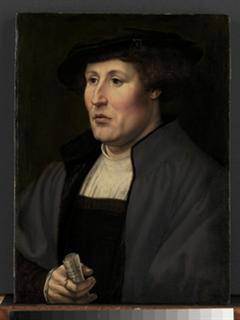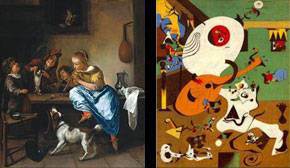
Jan Gossart
Portrait of a Man, 1520–25
Metropolitan Museum, The Friedsam Collection, Bequest of Michael Friedsam, 1931 (32.100.62)
‘Man, Myth, and Sensual Pleasures’: Jan Gossart at the Metropolitan Museum The first major exhibition in 45 years devoted to Jan Gossart (ca. 1478-1532)— one of the most innovative artists of the Burgundian-Habsburg Netherlands— is on view at The Metropolitan Museum of Art from October 6, 2010, through January 17, 2011]]>
Source: Metropolitan Museum
Man, Myth, and Sensual Pleasures: Jan Gossart’s Renaissance brings together the majority of Gossart’s paintings, drawings, and prints, and places them in the context of the influences on his transformation from Late Gothic Mannerism to the new Renaissance mode. Gossart was among the first northern artists to travel to Rome to make copies after antique sculpture and monuments and to introduce biblical and mythological subjects with erotic nude figures into the mainstream of northern painting. Most often credited with successfully assimilating Italian Renaissance style into northern European art of the early 16th century, he is the pivotal Old Master who redirected the course of early Flemish painting from the legacy of its founder, Jan van Eyck, and charted new territory that eventually led to the great age of Rubens.
Jan Gossart has not been the focus of a monographic exhibition since 1965 (in Rotterdam and Bruges) and has never before been the subject of an exhibition in the United States. Man, Myth, and Sensual Pleasures: Jan Gossart’s Renaissance is divided into eight sections and comprises approximately 145 works, including 50 of the artist’s 63 known paintings, 35 drawings, and six prints from U.S. and international collections. In order to consider Gossart within his artistic milieu, other works on view include antique and Renaissance sculpture, notably examples by Conrad Meit, paintings by Jan van Eyck, Gerard David, and Bernard van Orley, and prints and drawings by artists such as Marcantonio Raimondi, Dirk Vellert, Lucas van Leyden, Albrecht Dürer, and Jacopo de’Barbari. A number of works in the exhibition have been borrowed from various curatorial departments at the Metropolitan Museum, namely European Paintings, European Sculpture and Decorative Arts, Drawings and Prints, the Robert Lehman Collection, and Greek and Roman Art.
Among the many highlights from Gossart’s oeuvre in the exhibition are the Virgin and Child with Musical Angels and Saints Catherine and Dorothy (Malvagna Triptych), an exquisite gem-like altarpiece that is Gossart’s only surviving intact triptych, on rare loan from the Galleria Regionale della Sicilia in Palermo, Italy; the stunning Saint Luke Drawing the Virgin from the Kunsthistorisches Museum in Vienna; the magnificent Deesis panel on exceptional loan from the Prado; the Carondelet Diptych, considered one of the masterpieces of early Netherlandish portraiture, from the Musée du Louvre; the Portrait of an Old Couple, an astonishing study of old age painted on parchment from the National Gallery in London; and Portrait of a Man (Jan Jacobsz. Snoeck?), a remarkably well-preserved painting from the National Gallery of Art, Washington, D.C., that represents the peak of Gossart’s artistic achievement.
Follow us on:


